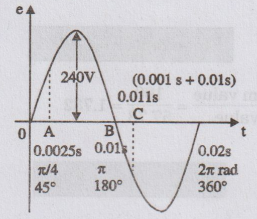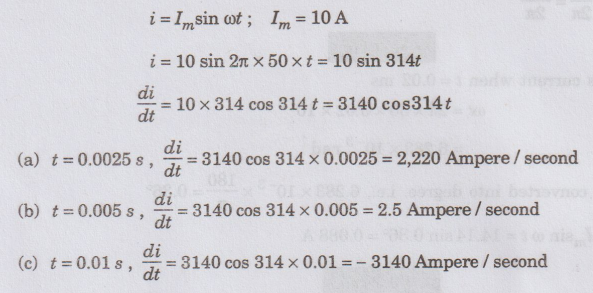Electric Circuit Analysis: Chapter - 3: Basic Circuit Analysis - AC
Sinusoidal voltages and currents
Waveform, Formula, Solved Example Problems
Voltages and currents varying as sine functions of time find more practical use. Hence, the rest of this topic will be devoted to the study of AC sinusoidal quantities.
SINUSOIDAL VOLTAGES AND CURRENTS
Voltages
and currents varying as sine functions of time find more practical use. Hence,
the rest of this topic will be devoted to the study of AC sinusoidal
quantities. It is also well known that any periodic source (with an arbitrary
form) can be represented by an equivalent combination of sinusoidal sources
(Fourier series).
A
sinusoidal voltage and current can be represented as
e
= Em sin at or v = Vm sin wt and
i
= Im sin wt
where
e or v and i are instantaneous values and Em or Vm and Im
are peak values. The symbol of 'w' stands for angular frequency in radians per
second.
v
= Vm sin (2лf) t
i
= Im sin (2 π f) t
w
= 2πf
f
= w / 2π = 1 / T
where
‘f’ is the frequency in cycles per second (Hz)
EXAMPLE
17:
A sinusoidal voltage of frequency 50 Hz has a maximum value of 240 V. What
is its equation? Find the value of the voltage at (a) time t = 0.0025 s after
the voltage passes through zero and is increasing and at (b) time t = 0.001 s
after the voltage passes through zero and is decreasing.

Solution
:
The
equation is
v
= Vmsin 2πft = 240 sin 2π × 50 × t
=
240 sin 314t Volts
(a)
At time t = 0.0025 s after the voltage passes through zero and is increasing
means the voltage is passing through A.
At
A, v = 240 sin (314 × 0.0025)
This
value (314 × 0.0025) is converted into degree i.e.,
(314
× 0.0025 × 180 / π = 45° )
v
= 240 sin 45°
(b)
At time, t = 0.001 s after the voltage passes through zero and is decreasing
implies at C (i.e. 0.001 s after B) i.e. at t = 0.011 s.
At
C, v = 240 sin (314 × 0.011)
Once
again 314 × 0.011 is in radians; the radian value is converted into degree
i.e.,
3.454 × 180/ π = 197.8°
U = 240 sin 197.8°
EXAMPLE
18:
A 50 Hz sinusoidal current wave has a peak amplitude of 10 A. Find the rate
of change of current in amperes per second at time t (a) 0.0025 (6) 0.005 and
(c) 0.01 s after i=0 and is increasing.
Solution:

EXAMPLE
19:
An alternating current of frequency 60 Hz has a maximum value of 120 A.
Write down the equation for its instantaneous value.
Solution:
f
= 60 Hz
Im
= 120 A
i
= Im sin wt
w
= 2лf = 2π × 60 = 377 rad/s
i
= 120 sin 377 t
EXAMPLE
20:
An alternating current is expressed as i = 14.14 sin 314 t. Determine rms
current, frequency and instantaneous current when t = 0.02 ms.
Solution:
i
= 14.14 sin 314t
i
= Im sin wt
Im
= 14:14 A
W
= 2πf = 314 rad/sec
(i)
RMS current I = Im / √2 = 14.14 / √2
I
= 10 A
(ii)
Frequency f= ω / 2π = 314 / 2π
f
= 50 Hz
(iii)
Instantaneous current when t = 0.02 ms
wt
= 2π × 50 × 0.02 × 10-3
=
6.283 × 10-3 rad
This
value is converted into degree. i.e., 6.283 × 10-3 × 180 / π = 0.36°
i
= Im sin wt = 14.14 sin 0.36° = 0.088 A
i
= 0.088 A
Electric Circuit Analysis: Chapter - 3: Basic Circuit Analysis - AC : Tag: : Waveform, Formula, Solved Example Problems - Sinusoidal voltages and currents